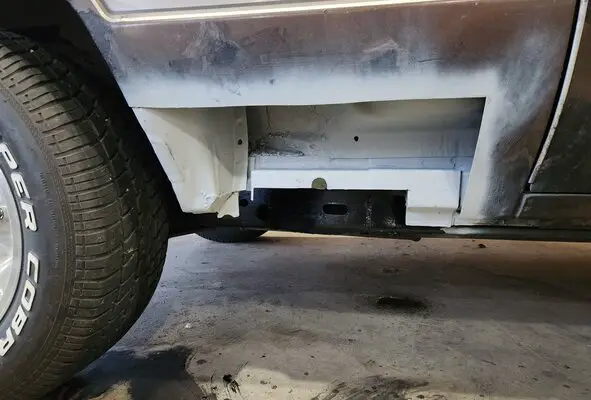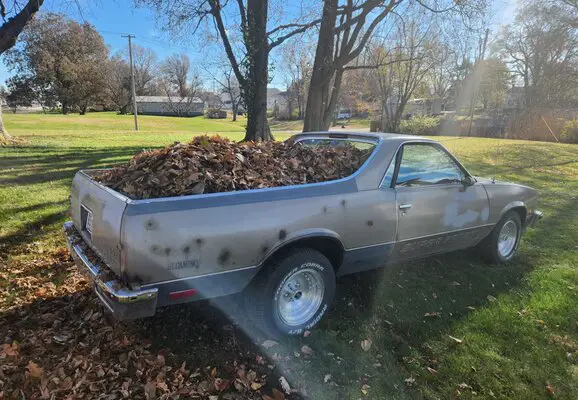Sorry for the lack of updates. Progress on the El Camino has been slow, but there is indeed progress. Life got in the way this summer, some of it good, some of it bad. On the bad side, my family and I lost a few weeks to yet another round of COVID-19 infections. This is our third infection. Nothing life threatening, but I'm sick of getting sick! On the good side, we've spent some time this summer vacationing. While on one of those vacations, I found a new toy that has slowed down progress on the El Camino. I bought a 1965 Chevy C10. Because, more projects are always better. 😉

The plan for the C10 is a modernized resto-mod, similar to the path we're taking with the El Camino. Major work on the truck will have to wait until the El Camino is closer to "finished". For now, I'm just enjoying having a new toy to play with.
Now then, back to the El Camino...
Rear and "Opera" Window Seals
A while back, we ordered new outer seals for the door glass and the triangular opera windows behind the doors. The original seals where cracked and leaking. The door glass seals were easy. We had the doors opened up anyway to do maintenance on the door latches and the electric windows, so we replaced the seals at the same time. They're held in by a few small screws that are easily accessible once the interior door panel is out of the way. The opera window seals were another animal entirely. In order to replace the outer seals, the opera windows need to be removed and reinstalled. The opera windows are glued in place. That's outside my skillset, so I went to the professionals.
I took the new seals and the car to an auto glass company that I've worked with in the past. While they were resealing windows, I asked them to take a look at the back glass. We had a water leak at the back of the cab and we couldn't figure out where it was coming from. The glass shop found that the glue holding the back glass had dried out and let go. In fact, the rear glass was loose enough to rattle in the frame. We knew we had a rattle, but we had no idea it was coming from the window. So, the glass shop reglued the rear window and driver side opera window. They had to hold off on resealing the passenger opera window because they found a rust hole underneath the old seal. I took the car back home and spent an afternoon cutting out the rust and welding in new steel. A second short visit to the glass shop took care of resealing the passenger opera window. The glass shop was great to work with. I would highly recommend Auto Glass Systems to anyone in or near Springfield, IL. Good people and good service. The car is sealed up now and window rattles are gone.
Quarter Panel Patching Begins
I've been putting off the exterior rust repair because it's going to take a LOT of work. I couldn't put it off any longer, so I devoted a free weekend to tearing into the worst rust hole (at least I hope it's the worst). The passenger side rear quarter panel, between the passenger door and the right rear wheel well had a rust hole through the outer skin all the way through the inner rocker panel. By the time I got done cutting out all of the rust, I could see the frame rail! (see pictures below).
Once the rot was out of the way, I treated the whole area with rust converter and weld-through primer, then began welding in new steel. The inner rocker was a mess. I sure am glad my repairs are hidden by the outer skin. It's all solid, but it isn't pretty. Before starting on the outer skin, I drenched everything with more rust converter, weld-through primer, and rust encapsulating paint.
The outer skin was actually the easiest part of the repair. I started with a replacement partial quarter panel patch. Of course, the fit of the replacement panel wasn't exact. But, after some cutting and massaging, I came up with something usable. This was my first attempt at fitting a patch panel in almost 25 years. So, as you can see in the pictures, it isn't perfect. But, it's good enough that it can be smoothed out during the filler stage without any deep puddles of mud. All-in-all, I'm happy with the repair. That's one hole down and several more to go.

The plan for the C10 is a modernized resto-mod, similar to the path we're taking with the El Camino. Major work on the truck will have to wait until the El Camino is closer to "finished". For now, I'm just enjoying having a new toy to play with.
Now then, back to the El Camino...
Rear and "Opera" Window Seals
A while back, we ordered new outer seals for the door glass and the triangular opera windows behind the doors. The original seals where cracked and leaking. The door glass seals were easy. We had the doors opened up anyway to do maintenance on the door latches and the electric windows, so we replaced the seals at the same time. They're held in by a few small screws that are easily accessible once the interior door panel is out of the way. The opera window seals were another animal entirely. In order to replace the outer seals, the opera windows need to be removed and reinstalled. The opera windows are glued in place. That's outside my skillset, so I went to the professionals.
I took the new seals and the car to an auto glass company that I've worked with in the past. While they were resealing windows, I asked them to take a look at the back glass. We had a water leak at the back of the cab and we couldn't figure out where it was coming from. The glass shop found that the glue holding the back glass had dried out and let go. In fact, the rear glass was loose enough to rattle in the frame. We knew we had a rattle, but we had no idea it was coming from the window. So, the glass shop reglued the rear window and driver side opera window. They had to hold off on resealing the passenger opera window because they found a rust hole underneath the old seal. I took the car back home and spent an afternoon cutting out the rust and welding in new steel. A second short visit to the glass shop took care of resealing the passenger opera window. The glass shop was great to work with. I would highly recommend Auto Glass Systems to anyone in or near Springfield, IL. Good people and good service. The car is sealed up now and window rattles are gone.
Quarter Panel Patching Begins
I've been putting off the exterior rust repair because it's going to take a LOT of work. I couldn't put it off any longer, so I devoted a free weekend to tearing into the worst rust hole (at least I hope it's the worst). The passenger side rear quarter panel, between the passenger door and the right rear wheel well had a rust hole through the outer skin all the way through the inner rocker panel. By the time I got done cutting out all of the rust, I could see the frame rail! (see pictures below).
Once the rot was out of the way, I treated the whole area with rust converter and weld-through primer, then began welding in new steel. The inner rocker was a mess. I sure am glad my repairs are hidden by the outer skin. It's all solid, but it isn't pretty. Before starting on the outer skin, I drenched everything with more rust converter, weld-through primer, and rust encapsulating paint.
The outer skin was actually the easiest part of the repair. I started with a replacement partial quarter panel patch. Of course, the fit of the replacement panel wasn't exact. But, after some cutting and massaging, I came up with something usable. This was my first attempt at fitting a patch panel in almost 25 years. So, as you can see in the pictures, it isn't perfect. But, it's good enough that it can be smoothed out during the filler stage without any deep puddles of mud. All-in-all, I'm happy with the repair. That's one hole down and several more to go.
Attachments
Last edited:





